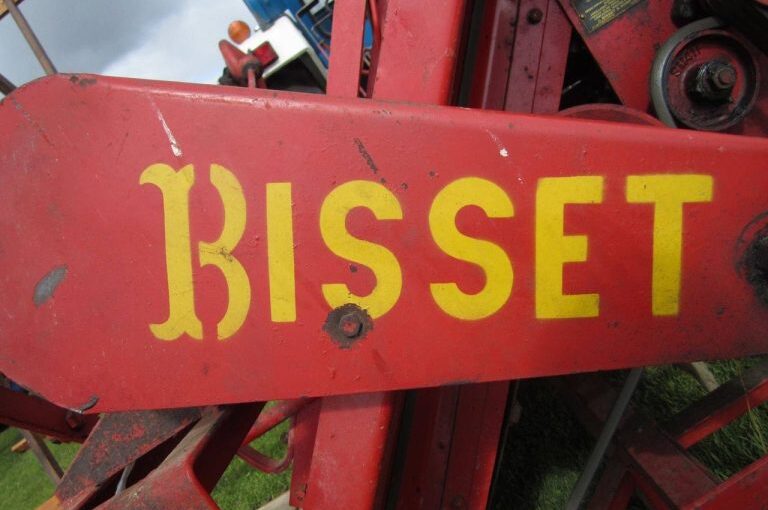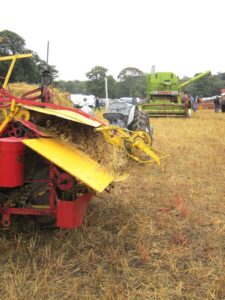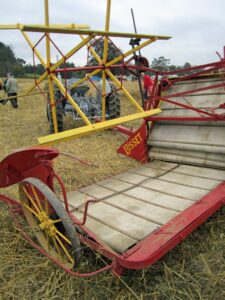A leader in the making of binders: J. Bisset & Sons, Blairgowrie
One of the well known implement and machine makers in Perthshire was J. Bisset & Sons, Marlee, then Greenback, Blairgowrie.
The company traded from at least 1867 until the mid 1960s. On 16 June 1966 the Directors passed a resolution to voluntarily wind up the company; it was dissolved on 20 November 1970. The company was noted for its potato diggers as well as its reaping machines and binders.
By the early 1890s the business had a number of its own mowers, reapers and reaping machines for sale. An advert in the Evening gazette (Aberdeen), of 27 July 1891 set out the main ones which it was to exhibit at the Highland Show as:
“Highland Show at Stirling
Stand no. 4
The “Bisset” binder, with new patent indispensable improvements of spring tension of endless aprons, regulated instantly from outside. The very thing everyone has been seeking after!
The “Bisset” patent mower, a new high-class machine
The “Speedwell” self-delivery reaper
The “Scotia” mower and reaper combined
J. Bisset & Sons, Blairgowrie”.
Bisset entered a number of these machines into trials and exhibitions. One of them was held in July 1892 at Blairgowrie, and as such was a local trial. The exhibition was arranged for Bisset to show one of its new patent chain-conveyor binders at work. An extensive account of it was published in the Dundee courier of 22 July 1892”
“Exhibition of patent reaping and binding machine at Blairgowrie
On Wednesday Messrs J. Bisset & Sons, Blairgowrie, exhibited one of their patent chain-conveyor binders in operation at the farm of Ardblair, near Blairgowrie, and occupied by Mr John Malloch. Th field chosen for cutting consisted of a heavy crop of green rye, and the satisfactory manner in which the “Bisset binder” operated called forth appreciative remarks of the spectators. Among those present on the occasion were-Mr Robert Carmichael, Drumfin; Mr Cree, Airntullo, Stanley; Mr John Robertson, jun, Taymount; Mr Anderson, Balbrogie; Mr Adam, Braidieston; Mr Henderson, Milton, Collace; Mr Patullo, Gask, Coupar Angus; Mr Grant, Ingliston, near Forfar; Mr Lamont, Inverquiech; Mr Ferguson, Wester Logie; the Messrs Grant, Tullyneddie; Mr Mclaren Pittendreich; Mr Thomas S. Bisset, Mr David Bisset, Mr John Doe, implement agent, Errol, &c. The “Bisset binder” is a new departure in design of reaping and binding machines, in so far as a spiked endless chain, held in position by slide guides, is used in it for moving the crop from where it falls towards the binding table, instead of the more intricate clumsy canvas and noisy cranks utilised in other machines. The chains, not requiring to be tight like canvas, are easily driven, and reduces the draught of the horses by a few hundredweight, while their action is instantaneous and certain. The grain never accumulates or goes off in bunches, as the output is uniform, no matter whether the weather is wet or dry. Possessing the open back and metallic conveyors, the “Bisset binder: is specially adapted for dealing with the rankest straw, and the height of its platform behind and the projecting spikes of the conveyors entirely prevent strong lodged crops from shooting back over the platform.
In order to show the spectators the efficiency if the method of conveying by chains, Mr Thomas S. Bisset, on Wednesday caused the two backmost of the four chains of the machine to be removed, when it was found that the remaining ones – eight inches apart – sufficed to carry along the crop and bring it properly into the binding machinery. This proved conclusively that with chains placed close together the shortest as well as the longest straw can be handled. One other apparent advantage which the machine possesses over others of its kind is that the cop at any point of the operation is not so high or permitted to fall so low, the extra height of the platform behind presenting the heaviest end of the crop falling nearer to the ground than twenty inches, while the greatest height lifted is not more than twenty-nine inches. As regards the driving gear, it may be described as very simple. The grain conveyors, the binding parts, and the reel are driven by a short chain from a pulley on the crank shaft at the front of the machine, doing away with any necessity for any machinery behind the driving wheel. The frame is light but substantial-three steel bars and one tube making up the whole, whilst the binding table has a long and easy action for bringing the twine to the middle of the sheaf, which is regulated partly by weight, and not altogether by the pressure of the packers, as in other machines. Reaping machines, generally, are very difficult to transport, but that of the “Bisset” is greatly facilitated by the fact that one man can in a few minutes, without using tools, raise the machine on two large wheels, making it balance, and ready to pass along narrow and rough lanes, or through a seven feet gateway. The case with which it performs its work, the fact that by its use the draught of the horses is reduced to the lowest minimum, and the simplicity and durability of its construction ought to commend the machine to agriculturists generally.”
Bisset also entered their new binder for the trials of the Royal Highland and Agricultural Society of Scotland in the summer of 1893. It worked well and took the highest place. It was fast, efficient, and performed well. All of these points were noted in its adverts for its binders. One of these was recorded in the Dundee courier of 5 September 1893:
“The new Bisset binder at the Highland and A. Society’s trial near Edinburgh, August 16th, took the highest position.
(Eleven competitors, including the 1st and 2d at the Royal England)
Cut the portion in the shortest time, 92 minutes. Lightest draught of the machines tested in the heavy crop. Shortest stubble, only 2 ¼ inches. Had the most difficult part of the field. The machine on our right took 76 minutes and the one on our left 90 minutes longer to finish. The splendid performance of our machine commanded the “special attention” of the spectators, The Scotsman’s report. Orders fulfilled on short notice.
J. Bisset & Sons, Blairgowrie”
Adverts continued to refer to this exhibition in the immediately following years, for example in the Northern Scot of 14 December 1895 and 15 October 1898:
“The new “Bisset” binder, ay the H. and A. S. Trial at Edinburgh in 1893 (the leading machines of England and America present), cut its portion in the shortest time, was the lightest draught of all in the heavier crop, and made the shortest stubble (only 2 ¼ inches). Jurors’ report says: “The binder seemed easy on the horses, doing its work speedily and well. It left an unusually low, even stubble, and divided the sheaves cleanly.”
The “Speedwell” reaper is easy going, makes neat work, and is durable.
Agents’ and customers’ orders placed early with our Representative in the north, Mr Robert Forbes, Woodhead, Kinloss, will have best attention.
J. Bisset & Sons.
Telegrams-“Forbes, Kinloss”
17th June 1895.”



